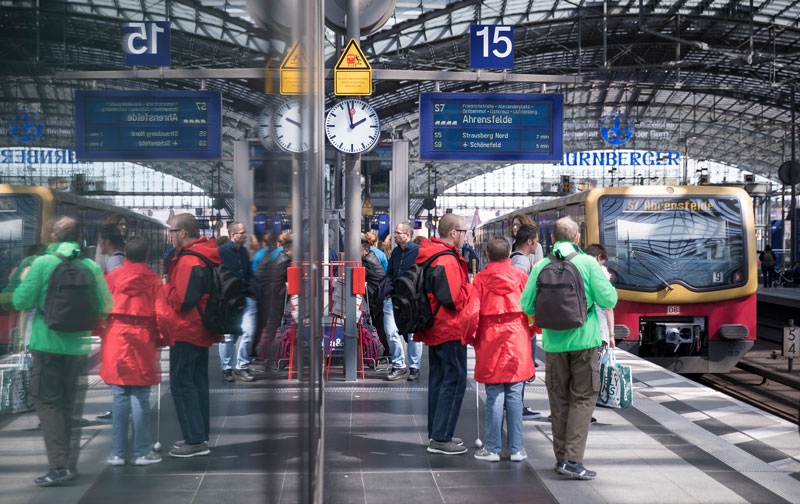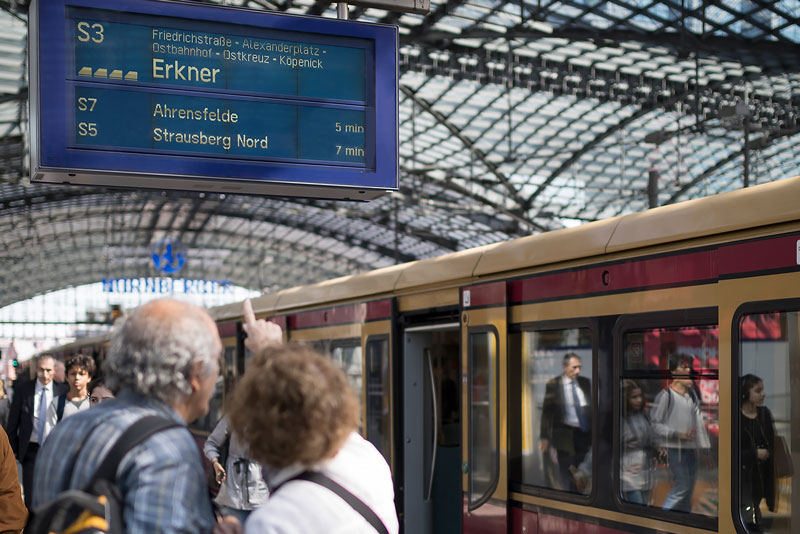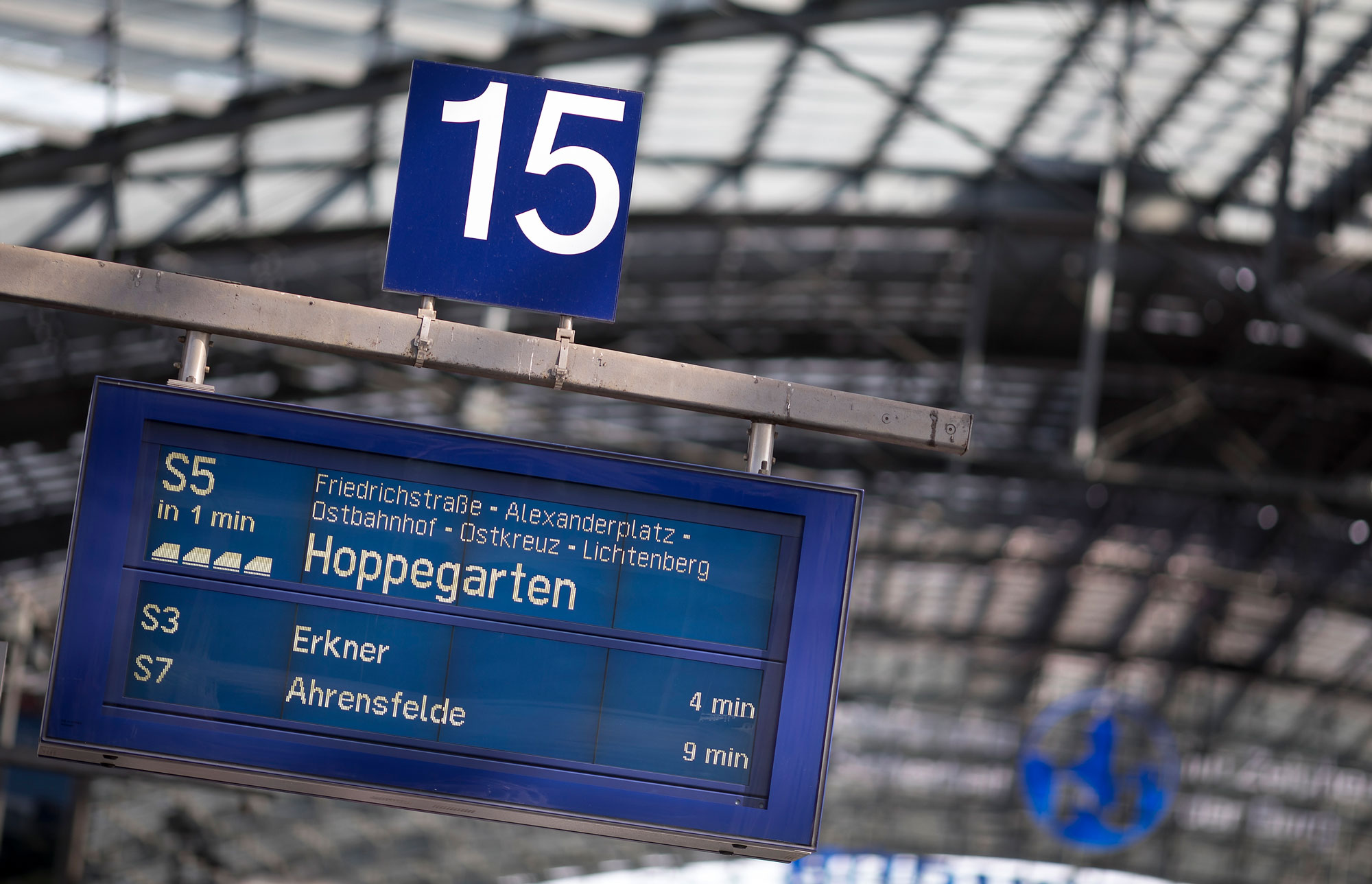Funkwerk Mobility Platform: our References
S-Bahn Berlin –
Germany
Proven in practice: On this page you will find use cases and references relating to the use of the Funkwerk Mobilty Platform.
S-Bahn Berlin is a suburban railway system for public transport in Berlin and the surrounding area. It was the first urban train line to be called an “S-Bahn” and stands alongside Hamburg’s suburban railway system as the only S-Bahn in Germany to be driven by direct current from a conductor rail attached to the side. The trains are operated and maintained by S-Bahn Berlin GmbH, which is a subsidiary of Deutsche Bahn.
The installed passenger information system (PIS for short) covers the entire route network of the S-Bahn as part of the local transport system of the city of Berlin. It covers around 328 kilometres and 166 stations, which are served by 16 S-Bahn lines – of which around 74 kilometres and 33 stations are in the state of Brandenburg. The network is divided into 21 areas, each of which is assigned a main station – usually a larger transfer station – to which several stations are then connected.

Different technologies in use
The passenger information system runs with two servers in hot stand-by mode and features different displays, announcements and sensors. Funkwerk has delivered and installed around 500 LCD and TFT displays and boards to date. Each display is controlled automatically. The announcements played through the public address system can be made automatically or manually via an intercom at the main station. Alternatively, pre-recorded announcements can be played at set times.
Highly automated information for travellers
The timetable data for the entire control range is automatically transferred from the timetable database in Frankfurt and processed in the passenger information system. Data is transferred to the system every day – ten days in advance. Once deviations have been detected due to disruptions (e.g. building work), the system automatically calculates the difference to the scheduled timetable. Forecasts are calculated and stored on the central passenger information server based on actual and target transit times. The relevant data is then shared with passengers via displays and announcements to make sure they are directly informed of any changes to the timetable.

High serviceability
The displays provide passengers with the following information:
- Announcement of the next three suburban rail services: Time, destination and line
- Detailed information on the next train shortly before arrival: upcoming stops before the end of the line and order of carriages
- Free text as required
This high degree of automation makes life easier for information managers – even in the event of deviations from regular operations. Even complex incidents can be entered manually in the system. Overall, the technology enables a high degree of serviceability in the field of modern and automated passenger information.
Components of the
Mobility Platform
Passenger information
Passenger information systems enable the fully automatic control of all processes in the operational sequence.
Displays
Indicators, displays, columns and monitors provide passengers with visual information in real time.
Public address
Public address systems ensure that important information and announcements are also given out acoustically.
Text-to-Speech
Text-to-speech is the digital generation of speech from text. Announcements can be synthesised live.
Funkwerk Mobility Platform: our References
S-Bahn Berlin – Germany
Proven in practice: On this page you will find use cases and references relating to the use of the Funkwerk Mobilty Platform.
S-Bahn Berlin is a suburban railway system for public transport in Berlin and the surrounding area. It was the first urban train line to be called an “S-Bahn” and stands alongside Hamburg’s suburban railway system as the only S-Bahn in Germany to be driven by direct current from a conductor rail attached to the side. The trains are operated and maintained by S-Bahn Berlin GmbH, which is a subsidiary of Deutsche Bahn.
The installed passenger information system (PIS for short) covers the entire route network of the S-Bahn as part of the local transport system of the city of Berlin. It covers around 328 kilometres and 166 stations, which are served by 16 S-Bahn lines – of which around 74 kilometres and 33 stations are in the state of Brandenburg. The network is divided into 21 areas, each of which is assigned a main station – usually a larger transfer station – to which several stations are then connected.

Different technologies in use
The passenger information system runs with two servers in hot stand-by mode and features different displays, announcements and sensors. Funkwerk has delivered and installed around 500 LCD and TFT displays and boards to date. Each display is controlled automatically. The announcements played through the public address system can be made automatically or manually via an intercom at the main station. Alternatively, pre-recorded announcements can be played at set times.
Highly automated information for travellers
The timetable data for the entire control range is automatically transferred from the timetable database in Frankfurt and processed in the passenger information system. Data is transferred to the system every day – ten days in advance. Once deviations have been detected due to disruptions (e.g. building work), the system automatically calculates the difference to the scheduled timetable. Forecasts are calculated and stored on the central passenger information server based on actual and target transit times. The relevant data is then shared with passengers via displays and announcements to make sure they are directly informed of any changes to the timetable.

High serviceability
The displays provide passengers with the following information:
- Announcement of the next three suburban rail services: Time, destination and line
- Detailed information on the next train shortly before arrival: upcoming stops before the end of the line and order of carriages
- Free text as required
This high degree of automation makes life easier for information managers – even in the event of deviations from regular operations. Even complex incidents can be entered manually in the system. Overall, the technology enables a high degree of serviceability in the field of modern and automated passenger information.
Components of the
Mobility Platform
Passenger information
Passenger information systems enable the fully automatic control of all processes in the operational sequence.
Displays
Indicators, displays, columns and monitors provide passengers with visual information in real time.
Public address
Public address systems ensure that important information and announcements are also given out acoustically.
Text-to-Speech
Text-to-speech is the digital generation of speech from text. Announcements can be synthesised live.

References
SS-Bahn Berlin – Germany
S-Bahn Berlin is a suburban railway system for public transport in Berlin and the surrounding area. It was the first urban train line to be called an “S-Bahn” and stands alongside Hamburg’s suburban railway system as the only S-Bahn in Germany to be driven by direct current from a conductor rail attached to the side. The trains are operated and maintained by S-Bahn Berlin GmbH, which is a subsidiary of Deutsche Bahn.
The installed passenger information system (PIS for short) covers the entire route network of the S-Bahn as part of the local transport system of the city of Berlin. It covers around 328 kilometres and 166 stations, which are served by 16 S-Bahn lines – of which around 74 kilometres and 33 stations are in the state of Brandenburg. The network is divided into 21 areas, each of which is assigned a main station – usually a larger transfer station – to which several stations are then connected.

Different technologies in use
The passenger information system runs with two servers in hot stand-by mode and features different displays, announcements and sensors. Funkwerk has delivered and installed around 500 LCD and TFT displays and boards to date. Each display is controlled automatically. The announcements played through the public address system can be made automatically or manually via an intercom at the main station. Alternatively, pre-recorded announcements can be played at set times.
Highly automated information for travellers
The timetable data for the entire control range is automatically transferred from the timetable database in Frankfurt and processed in the passenger information system. Data is transferred to the system every day – ten days in advance. Once deviations have been detected due to disruptions (e.g. building work), the system automatically calculates the difference to the scheduled timetable. Forecasts are calculated and stored on the central passenger information server based on actual and target transit times. The relevant data is then shared with passengers via displays and announcements to make sure they are directly informed of any changes to the timetable.

High serviceability
The displays provide passengers with the following information:
- Announcement of the next three suburban rail services: Time, destination and line
- Detailed information on the next train shortly before arrival: upcoming stops before the end of the line and order of carriages
- Free text as required
This high degree of automation makes life easier for information managers – even in the event of deviations from regular operations. Even complex incidents can be entered manually in the system. Overall, the technology enables a high degree of serviceability in the field of modern and automated passenger information.
Components of the
Mobility Platform
Passenger information
Passenger information systems enable the fully automatic control of all processes in the operational sequence.
Displays
Indicators, displays, columns and monitors provide passengers with visual information in real time.
Public address
Public address systems ensure that important information and announcements are also given out acoustically.
Text-to-Speech
Text-to-speech is the digital generation of speech from text. Announcements can be synthesised live.
